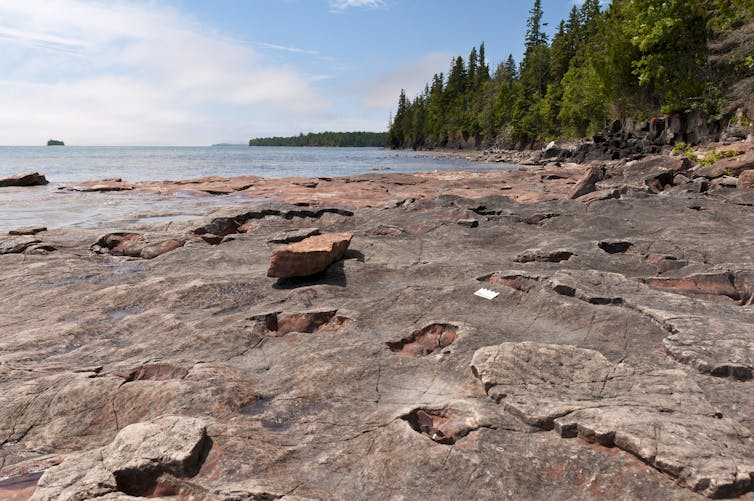
Geologists have dubbed Earth’s middle age the “boring billion”. Occurring some 1,800 to 800 million years ago, it has long been considered a period when little happened on Earth in terms of biological evolution, climate, or the chemistry of the oceans and atmosphere. But emerging evidence now suggests that the “boring billion” may have been far more dynamic than that.
Our planet has been shaped by many monumental events. From the Cambrian explosion around 540 million years ago, when most animal forms appeared, to the rise and fall of the dinosaurs, the dramatic course of biological evolution is well documented by the fossil record. Similarly, from the glaciations of the most recent ice age, to much earlier “snowball Earth” periods, when the entire planet may have frozen over for millions of years, climate change has left a clear imprint on the geological record.
But then we come to the “boring billion”, where the rocks appear to give us startling evidence for, well, not much really.

At first glance, the Earth seems to have been stuck in perpetual stasis across this billion year interval. The planet was likely somewhat warmer than today, but there is zero evidence in the rocks for any dramatic change in climate. Oxygen in the atmosphere was stuck at a level much lower than we have today, and indeed much of the global ocean was entirely devoid of oxygen, leading to inhospitable seas that were rich in either iron or toxic hydrogen sulphide (the smelly gas released by rotten eggs).
While the first eukaryotes (cells with a nucleus) had already evolved, the pace of biological evolution appeared to have stalled. Until recently, the most advanced traces of life found at any time through this interval were tiny organic microfossils in aquatic environments, and if you went back in time on safari, you would be confronted by entirely barren landscapes.
All of this led the ever-mischievous scientist Roger Buick, in a seminal 1995 publication, to paraphrase Winston Churchill with the immortal line “never in the course of Earth’s history did so little happen to so much for so long”. Apparently inspired, the late palaeontologist Martin Brasier then coined the term “boring billion”, and it is this soundbite that has since become firmly embedded in geological consciousness.
But geologists have recently shown renewed interest in this time period (which forms part of what we call the Proterozoic Eon), and I would now argue that the “boring billion” is every bit as exciting and important to understand as anything that happened in the past 500m years of Earth history. If we do not understand periods of relative stasis, then what hope do we have for understanding times of monumental change?
Stinky oceans
So how does a scientist first get interested in all this? As is often the case, it happened almost by accident. While a PhD student, I spent my time thinking about mud at the bottom of the modern ocean, which tends to be full of the toxic hydrogen sulphide mentioned above. At about the same time, Don Canfield of the University of Southern Denmark started writing about stagnant, stinking, hydrogen sulphide-rich oceans during the “boring billion”. The idea captured my imagination.

So, when an opportunity arose to work with Don I seized the moment and started to attack 1.8 billion year old rocks from the north shore of Lake Superior with some of the tools we were using to understand mud in the modern ocean. The results were cool – we did indeed find clear evidence for widespread stinking oceans devoid of oxygen.
But this was just the start. Since then it has become clear that oxygen levels were not static at all during the “boring billion”, and in fact geologists have found clear evidence for intervals of increased oxygen. (Why didn’t this prompt evolution on the scale of the Cambrian? Partly because we are still talking about relatively low levels. But there’s also huge argument among scientists over whether oxygen spurred early animal evolution, or whether the evolution of animals allowed oxygen levels to rise).

Paleontologists have also recently begun to identify a much richer tapestry of life across the interval, which includes an increase in the size of seaweed-like algae coincident with rising levels of oxygen. These fossils might not appear as dramatic as the early animals of the Cambrian explosion, but they provide a crucial window into the course of biological evolution on Earth, and help fuel the debate over the importance of oxygen in early evolution.
Against the backdrop of these advances, it is also clear that we have only just begun to piece together the enigmatic history of this fascinating time period. We need to look at the rocks with new techniques and new eyes to unravel the subtle clues that they hide. Likewise, new locations housing spectacular fossils are sure to be found. It is fair to expect that in 10 or 20 years we will have a profoundly different perception of the so-called “boring billion”.![]()
This article is republished from The Conversation by Simon Poulton, Professor of Biogeochemistry and Earth History, University of Leeds under a Creative Commons license. Read the original article.
Get the TNW newsletter
Get the most important tech news in your inbox each week.





